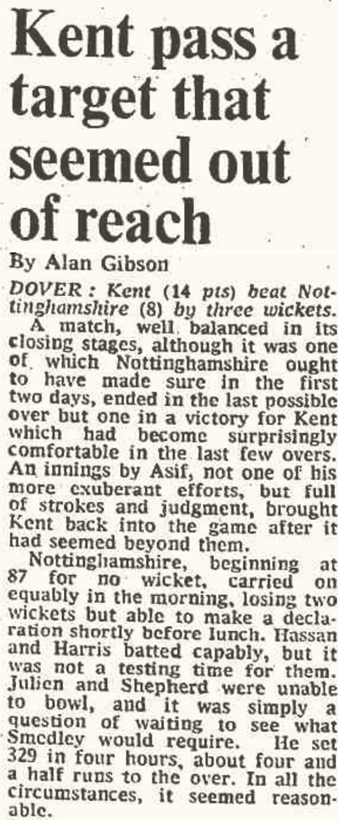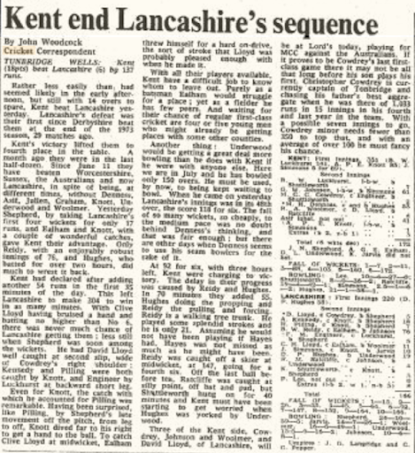This week in 1975 the cricket took a mid-season breather. There was no international cricket and no round of Championship games starting on Saturday because the 55-over final was being played at Lord’s. A dull affair this was. Middlesex struggled to 146 all out in the 53rd over, getting that many chiefly thanks to opener Mike Smith’s 82 (this was MJ Smith, to differentiate from Warwickshire’s MJK Smith). Leicestershire’s innings followed one of the primary conventions of limited-overs cricket at that time: that it must take every opportunity to resemble first-class cricket as closely as possible. Illingworth’s team took 52 overs to win by five wickets, a match scoring rate of 2.84 an over. I have often written how low-scoring one-day games are often the best kind, but this match was not among them because Leicestershire never lost enough wickets for the result to be in doubt.
Another of
these conventions was that cricket writers should take all opportunities to denigrate
one-day cricket. Arlott, Blofeld and Woodcock all observed this one during this
week. Of course, I agree with them that the longer the game the better it is as
a format, but recognise that the shorter forms have intrinsic value of their
own and brings benefits to first-class cricket. For example, since 1967, the
year I featured in a similar exercise to this one, there had been a clear improvement
in the quality of fielding, thanks largely to the influence of one-day cricket.
The great writers might have appreciated it more had they known what was
coming.
There was an
interval of 17 days between the end of the first test match and the beginning
of the second, a period into which some test series fit these days. The
Australians were kept busy, aping the county schedule. The disappearance of
tourist fixtures from the schedule is one of the differences between then and
now that is the most regretted, though the itinerary reads as if might have
been a sentence imposed by a court. This week, they went from Hove to
Chesterfield and then on to Manchester. There were no rest days between matches,
though they got Sundays off. The county games attracted good crowds and the
hosts were usually at full strength or something near it. Players on the fringe
of the test side (or who thought they were) leapt at the opportunity to impress.
This week, Barry Wood made 84 not out for Lancashire against Lillee, Thomson
and Walker and opened the batting for England at Lord’s the following Thursday.
There was an
odd result in the Sunday League between Essex and Worcestershire, or one that
will appear odd to the modern spectator. Essex made 207 off the full 40 overs.
Rain briefly interrupted Worcestershire’s reply at 57 for five. Six overs were
lost. Worcestershire’s target was reduced from 151 off 22 overs to 119 from 16,
very challenging in its time, but significantly more achievable. There was no
adjustment for wickets lost. Wicketkeeper Rodney Cass slogged Worcestershire to
victory with nine wickets down. DLS may not be as easy to understand as a
simple calculation of run rate, but has justice on its side.
One of the
game’s more distinguished international careers came to an end this week, or
rather it was discovered to have ended a few weeks before, at Lord’s in the
World Cup Final. Rohan Kanhai was omitted from the West Indies squad to tour
Australia. He made his point a couple of days later with 178 not out for
Warwickshire against one of the stronger counties, Leicestershire. Kanhai
finished the season top of the first-class batting averages with 82.53. How the
West Indies could do with him now. I repeat that the saddest thing in my
cricket-watching life has been the decline of West Indian cricket.
This week
(2025 now) they were bowled out for 27, though I must confess that here in New
Zealand we were cheering for Australia, something that we do only in the most extreme
circumstances. I received a text from one of the RA Vance Stand Pessimists when
the score at Sabina Park was 11 for six. “Could this be the day?”, it continued,
“70 years”. This, of course, a reference to the day when New Zealand were
bowled out for 26 by Hutton’s England, the lowest innings score in 148 years of
test cricket. Every few years there is a day when we think that we can pass on
the poisoned chalice. Australia 18 for six, Cape Town 2011…England 18 for six,
Auckland 2018…India 19 for six at Adelaide, 2020. Kingston 2025 is now another
signpost in this Vale of Tears.












